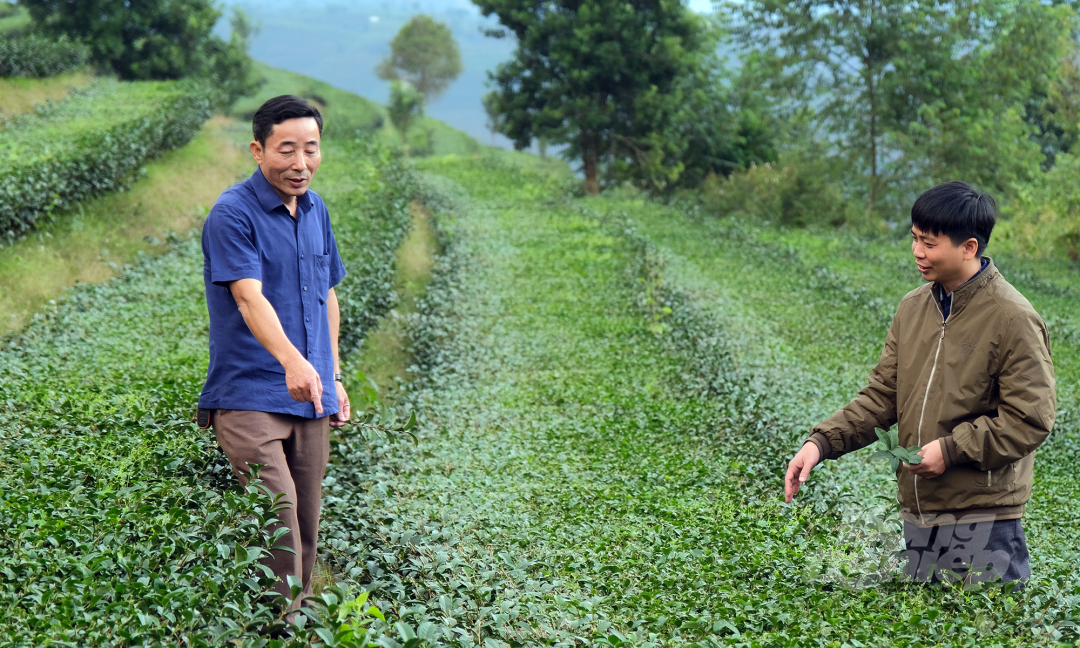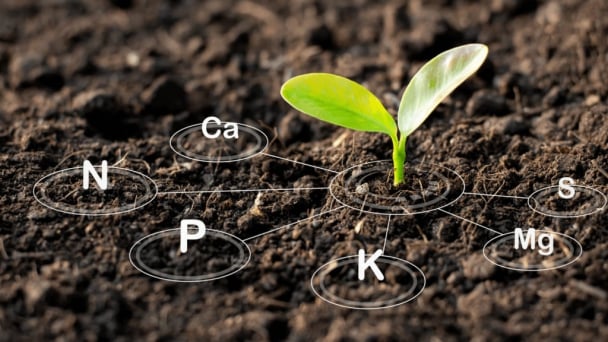May 20, 2025 | 11:36 GMT +7
May 20, 2025 | 11:36 GMT +7
Hotline: 0913.378.918
May 20, 2025 | 11:36 GMT +7
Hotline: 0913.378.918

Secretary of Ban Bo Commune’s Party Committee, Mr. Nguyen Xuan Hoan, and an official from Tam Duong District's Agriculture and Rural Development Office visited a Kim Tuyen tea hill. Photo: Bao Thang.
Stretching towards the horizon are tea hills of hundred-meter height with plants standing straightly rows after rows. That is the first impression catching the eyes of anybody when visiting Ban Bo Commune, Tam Duong District, Lai Chau Province.
"Initially, it was very difficult to mobilize farmers in growing tea because tea is a long-term industrial plant that does not bring food right away. We had to go from house to house to convince and encourage locals and civil servants to spend their weekends on preparing land for growing tea," Hoan recalled.
Before 2008, Ban Bo Commune used to be a particularly disadvantageous locality in Tam Duong District. Hoan said local people's life at that time faced many difficulties with a poverty rate of over 70%.
A breakthrough came to Ban Bo in 2008, when the commune was supported by Lai Chau Province and Tam Duong District to experiment in planting three new tea varieties including the Kim Tuyen. After one year, the hybrid Kim Tuyen was recognized as a key tea variety for restructuring crops on sloping land. From the first 8 hectares, the commune switched strongly to developing the plantation associated at the same time with processing and production. Up to now, the whole Ban Bo Commune has a total of nearly 1,000 ha of Kim Tuyen tea.
With the motto "go to every alley, knock on the door of each house and convince each local", Ban Bo Commune persistently mobilized all people to participate in Kim Tuyen tea growing. As a result, by 2010, the tea had covered almost the whole commune, even the last two villages of the Mong people on high mountains.
During meetings with local people, authority leaders patiently listened to, grasped their aspirations and selected households with adequate conditions of finance, labor and land easy for investment in tea planting. Na Ly and Hung Phong villages were the two locations selected for the pilot planting plan in the first days.
Not disappointing people, after 3 years of piloting through the assessment of provincial and district specializing agencies and the Northern Tropical Plants Institute, Kim Tuyen tea variety has been confirmed suitable for growing in Ban Bo. Compared with the Shan tea variety grown before with unstable output, Kim Tuyen has remarkably helped farmers improve their living conditions.
Tea now is growing well and fast covering all over the commune. Although there are no machines used during the planting, growers and authority supporting officials are all working manually with the use of simple farming tools. Mr. Hoan was among those who have for 10 years directly participated in the plan with a motto of “eating together and working with locals”.

With a tea hill of 1,000 ha, Ban Bo Commune makes up nearly half of the total tea-growing areas of Tam Duong District. Photo: Bao Thang.
With the best conditions provided by communal, provincial, and district supporting policies, people have increasingly believed in the Party Committee’s and Government’s plan and orientation of economic development from tea plants. More of them have registered to actively participate in expanding the plan.
Growing tea has so far become a movement in Ban Bo Commune since 2014 with many annual targets assigned by the province and district having been completed and over-fulfilled by the commune.
Up to now, hundreds of hectares of inefficient hilly fields have been converted to tea-growing under the provincial scheme. Every year, the commune has newly planted dozens of hectares of tea. Along with expanding the areas, Ban Bo has also actively implemented a farming model following the VietGAP standards. Growers are instructed not to spray pesticides and herbicides and harvest under technical procedures.
According to statistics from Ban Bo Commune, in 2018, the tea productivity in the area was twice as high as that of rice and corn. Due to tea growing, people have more jobs. Deforestation and burning fields are also limited. In many villages such as Hung Phong, Coc Phung, and Nam Tang, the poverty rate is only 1-2%. Some typical households in the area annually can earn tens to hundreds of millions of dong from tea.
"If you are attached with agriculture, you will understand it is so important to plan on what plant to grow and what cattle to raise in the region. Ban Bo Commune has determined to focus on developing the key plant", Party Secretary Nguyen Xuan Hoan expressed.
In Tam Duong's agricultural development goal 2022, the district is piloting a project on developing macadamia intercropped with tea, of which Ban Bo will have over 50 ha of intercropping area.
On the basis of planning on crops with high economic efficiencies such as tea and macadamia, Tam Duong District also focuses on building new rural areas in communes and townships. At the same time, the district reviews and develops production development plans focusing on expanding rice and maize areas, protecting well tropical fruits such as banana, passion fruit, and oranges.
Mr. Nguyen Hong Quan, Head of Tam Duong District’s Agriculture and Rural Development Office said that the district has planned and will organize a new tea plantation according to its plan. For the high fields where there is not enough water for irrigation, the district is studying to change to other crops such as corn and vegetables to ensure income and life for the people.
Translated by Linh Nguyen

(VAN) For years, the CRISPR-Cas9 genome technology has been reshaping genetic engineering, a precision tool to transform everything from agriculture to medicine.

(VAN) Vietnam aims to become a 'leader' in the region in the capacity and managing effectively soil health and crop nutrition.
![Reducing emissions from rice fields: [Part 1] Farming clean rice together](https://t.ex-cdn.com/nongnghiepmoitruong.vn/608w/files/news/2025/05/05/z6509661417740_a647202949c539012a959e841c03e1d3-nongnghiep-143611.jpg)
(VAN) Growing clean rice helps reduce environmental pollution while increasing income, allowing farmers to feel secure in production and remain committed to their fields for the long term.
/2025/05/19/5136-1-144800_230.jpg)
(VAN) The Nghe An Provincial People's Committee has just approved the list of beneficiaries eligible for revenue from the Emission Reductions Payment Agreement (ERPA) in the North Central region for the year 2025.

(VAN) 14 out of 35 domesticated elephants in Dak Lak province have had their living conditions improved, with 11 of them currently participating in the non-riding elephant tourism model.

(VAN) Muong Nhe Nature Reserve hopes that being upgraded to a national park will lay the foundation for forest protection efforts to be carried out in a systematic, modern, and sustainable manner.
/2025/05/16/3923-2-171845_52.jpg)
(VAN) Lower costs, higher yields, and improved soil quality are outstanding benefits that soybeans bring when integrated into the crop rotation system.